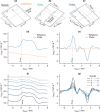Droplet Memory on Liquid-Infused Surfaces
- PMID: 37067495
- PMCID: PMC10157887
- DOI: 10.1021/acs.langmuir.3c00289
Droplet Memory on Liquid-Infused Surfaces
Abstract
The knowledge of droplet friction on liquid-infused surfaces (LIS) is of paramount importance for applications involving liquid manipulation. While the possible dissipation mechanisms are well-understood, the effect of surface texture has thus far been mainly investigated on LIS with highly regular solid topographies. In this work, we aim to address this experimental gap by studying the friction experienced by water droplets on LIS based on both random and regular polysilsesquioxane nanostructures. We show that the available models apply to the tested surfaces, but we observe a previously unreported droplet memory effect: as consecutive droplets travel along the same path, their velocity increases up to a plateau value before returning to the original state after a sufficiently long time. We study the features of this phenomenon by evaluating the motion of droplets when they cross the path of a previous sequence of droplets, discovering that moving droplets create a low-friction trace in their wake, whose size matches their base diameter. Finally, we attribute this to the temporary smoothing out of an initially conformal lubricant layer by means of a Landau-Levich-Derjaguin liquid film deposition behind the moving droplet. The proposed mechanism might apply to any LIS with a conformal lubricant layer.
Conflict of interest statement
The authors declare no competing financial interest.
Figures






References
-
- Lafuma A.; Quéré D. Slippery Pre-suffused Surfaces. EPL Europhys. Lett. 2011, 96, 56001.10.1209/0295-5075/96/56001. - DOI
-
- Samaha M. A.; Gad-el-Hak M. Slippery Surfaces: A Decade of Progress. Phys. Fluids 2021, 33, 071301.10.1063/5.0056967. - DOI
-
- Li J.; Ueda E.; Paulssen D.; Levkin P. A. Slippery Lubricant-Infused Surfaces: Properties and Emerging Applications. Adv. Funct. Mater. 2019, 29, 1802317.10.1002/adfm.201802317. - DOI
LinkOut - more resources
Full Text Sources
Miscellaneous

